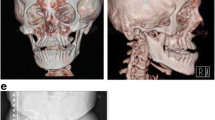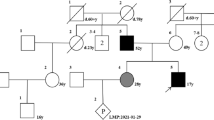Abstract
The latent transforming growth factor-beta-binding protein 3 (LTBP3), encoding extracellular matrix proteins, plays a role in skeletal formation. Mutations in LTBP3 have been associated with various types of skeletal dysplasia. We aimed to characterize clinical and molecular features of more patients with mutations in the gene, which may help suggest genotype–phenotype correlation. The first two East Asian patients with short stature, heart defects, and orodental anomalies having LTBP3 mutations were identified. Whole exome and Sanger sequencing revealed that the one with a novel heterozygous missense (c.2017G>T, p.Gly673Cys) mutation in LTBP3 had clinical features consistent with acromicric dysplasia (ACMICD). The variant was located in the highly conserved EGF-like calcium-binding domain adjacent to the single reported LTBP3 variant associated with ACMICD. This finding supports that LTBP3 is a disease gene for ACMICD. Another patient with a novel homozygous splice site acceptor (c.1721-2A>G) mutation in LTBP3 was affected with dental anomalies and short stature (DASS). Previously undescribed orodental features included multiple unerupted teeth, high-arched palate, and microstomia found in our patient with ACMICD, and extensive dental infection, condensing osteitis, and deviated alveolar bone formation in our patient with DASS. Our results and comprehensive reviews suggest a genotype–phenotype correlation: biallelic loss-of-function mutations cause DASS, monoallelic missense gain-of-function mutations in the EGF-like domain cause ACMICD, and monoallelic missense gain-of-function mutations with more drastic effects on the protein functions cause geleophysic dysplasia (GPHYSD3). In summary, we expand the phenotypic and genotypic spectra of LTBP3-related disorders, support that LTBP3 is a disease gene for ACMICD, and propose the genotype–phenotype correlation of LTBP3 mutations.




Similar content being viewed by others
References
Adzhubei IA et al (2010) A method and server for predicting damaging missense mutations. Nat Methods 7:248–249. https://doi.org/10.1038/nmeth0410-248
Dugan SL et al (2015) New recessive truncating mutation in LTBP3 in a family with oligodontia, short stature, and mitral valve prolapse. Am J Med Genet A 167:1396–1399. https://doi.org/10.1002/ajmg.a.37049
Faivre L et al (2001) Acromicric dysplasia: long term outcome and evidence of autosomal dominant inheritance. J Med Genet 38:745–749
Guerra RS, Fonseca I, Pichel F, Restivo MT, Amaral TF (2014) Hand length as an alternative measurement of height. Eur J Clin Nutr 68:229–233. https://doi.org/10.1038/ejcn.2013.220
Guo D-c et al (2018) LTBP3 pathogenic variants predispose individuals to thoracic aortic aneurysms and dissections. Am J Hum Genet 102:706–712. https://doi.org/10.1016/j.ajhg.2018.03.002
Huckert M et al (2015) Mutations in the latent TGF-beta binding protein 3 (LTBP3) gene cause brachyolmia with amelogenesis imperfecta. Hum Mol Genet 24:3038–3049. https://doi.org/10.1093/hmg/ddv053
Hug N, Longman D, Caceres JF (2016) Mechanism and regulation of the nonsense-mediated decay pathway. Nucleic Acids Res 44:1483–1495. https://doi.org/10.1093/nar/gkw010
Jagadeesh KA et al (2016) M-CAP eliminates a majority of variants of uncertain significance in clinical exomes at high sensitivity. Nat Genet 48:1581–1586. https://doi.org/10.1038/ng.3703
Le Goff C et al (2011) Mutations in the TGFbeta binding-protein-like domain 5 of FBN1 are responsible for acromicric and geleophysic dysplasias. Am J Hum Genet 89:7–14. https://doi.org/10.1016/j.ajhg.2011.05.012
Lek M et al (2016) Analysis of protein-coding genetic variation in 60,706 humans. Nature 536:285. https://doi.org/10.1038/nature19057
McInerney-Leo AM et al (2016) Mutations in LTBP3 cause acromicric dysplasia and geleophysic dysplasia. J Med Genet 53:457–464. https://doi.org/10.1136/jmedgenet-2015-103647
Mora M et al (2014) New splice site acceptor mutation in AIRE gene in autoimmune polyendocrine syndrome type 1. PLoS One 9:e101616. https://doi.org/10.1371/journal.pone.0101616
Nagy E, Maquat LE (1998) A rule for termination-codon position within intron-containing genes: when nonsense affects RNA abundance. Trends Biochem Sci 23:198–199
Ng PC, Henikoff S (2003) SIFT: Predicting amino acid changes that affect protein function. Nucleic Acids Res 31:3812–3814
Noor A et al (2009) Oligodontia is caused by mutation in LTBP3, the gene encoding latent TGF-beta binding protein 3. Am J Hum Genet 84:519–523. https://doi.org/10.1016/j.ajhg.2009.03.007
Porntaveetus T, Srichomthong C, Ohazama A, Suphapeetiporn K, Shotelersuk V (2017) A novel GJA1 mutation in oculodentodigital dysplasia with extensive loss of enamel. Oral Dis 23:795–800. https://doi.org/10.1111/odi.12663
Rastogi P, Kanchan T, Menezes RG, Yoganarasimha K (2009) Middle finger length—a predictor of stature in the Indian population. Med Sci Law 49:123–126. https://doi.org/10.1258/rsmmsl.49.2.123
Robertson IB, Horiguchi M, Zilberberg L, Dabovic B, Hadjiolova K, Rifkin DB (2015) Latent TGF-β-binding proteins. Matrix Biol 47:44–53. https://doi.org/10.1016/j.matbio.2015.05.005
Schrodinger LLC (2015) The PyMOL Molecular Graphics System, Version 2.0. https://pymol.org/
Souma T et al (2016) Angiopoietin receptor TEK mutations underlie primary congenital glaucoma with variable expressivity. J Clin Investig 126:2575–2587. https://doi.org/10.1172/JCI85830
Turan S, Bereket A, Omar A, Berber M, Ozen A, Bekiroglu N (2005) Upper segment/lower segment ratio and armspan-height difference in healthy Turkish children. Acta Paediatr 94:407–413
Venselaar H, te Beek TA, Kuipers RK, Hekkelman ML, Vriend G (2010) Protein structure analysis of mutations causing inheritable diseases. An e-Science approach with life scientist friendly interfaces. BMC Bioinform 11:548. https://doi.org/10.1186/1471-2105-11-548
Verselis SJ, Rheinwald JG, Fraumeni JF, Li FP (2000) Novel p53 splice site mutations in three families with Li–Fraumeni syndrome. Oncogene 19:4230. https://doi.org/10.1038/sj.onc.1203758
Zilberberg L, Todorovic V, Dabovic B, Horiguchi M, Courousse T, Sakai LY, Rifkin DB (2012) Specificity of latent TGF-β binding protein (LTBP) incorporation into matrix: role of fibrillins and fibronectin. J Cell Physiol 227:3828–3836. https://doi.org/10.1002/jcp.24094
Zhu M, Jiao YH, Xiong F, Xie F, Guo SJ, Cun YS (2015) Analysis of limb segments length and body proportion of southern Chinese children and adolescents. J Paediatr Child Health 51:1164–1171. https://doi.org/10.1111/jpc.12978
Acknowledgements
This study was supported by the Thailand Research Fund (RSA6280001, DPG6180001), Faculty of Dentistry, Chulalongkorn University (DRF62003), the Chulalongkorn Academic Advancement Into Its Second Century Project, and the Newton Fund. NI is supported by Ratchadapisek Somphot Fund for Postdoctoral Fellowship, Chulalongkorn University. ST is supported by the 100th Anniversary Chulalongkorn University Fund for Doctoral Scholarship and the 90th Anniversary of Chulalongkorn University Fund (Ratchadaphiseksomphot Endowment Fund). We thank Mr. Trakarn Sookthonglarng and Mr Yuttupong Kunchanapruek for blood collection.
Author information
Authors and Affiliations
Contributions
NI contributed to conception, data analysis, and drafting the manuscript; TT, ST, KS contributed to data analysis and critical revision of the manuscript; VS and TP contributed to data acquisition and analysis, drafting and critical revision of the manuscript. All authors gave final approval and agree to be accountable for all aspects of the work.
Corresponding author
Ethics declarations
Conflict of interest
Narin Intarak declares that he has no conflict of interest. Thanakorn Theerapanon declares that he has no conflict of interest, Sermporn Thaweesapphithak declares that he has no conflict of interest. Kanya Suphapeetiporn declares that she has no conflict of interest. Thantrira Porntaveetus declares that she has no conflict of interest. Vorasuk Shotelersuk declares that he has no conflict of interest.
Ethical approval
All procedures performed in studies involving human participants were in accordance with the ethical standards of the institutional and/or national research committee and with the 1964 Helsinki declaration and its later amendments or comparable ethical standards.
Informed consent
Informed consent was obtained from all individual participants included in the study.
Additional information
Communicated by Stefan Hohmann.
Publisher’s Note
Springer Nature remains neutral with regard to jurisdictional claims in published maps and institutional affiliations.
Electronic supplementary material
Below is the link to the electronic supplementary material.
Rights and permissions
About this article
Cite this article
Intarak, N., Theerapanon, T., Thaweesapphithak, S. et al. Genotype–phenotype correlation and expansion of orodental anomalies in LTBP3-related disorders. Mol Genet Genomics 294, 773–787 (2019). https://doi.org/10.1007/s00438-019-01547-x
Received:
Accepted:
Published:
Issue Date:
DOI: https://doi.org/10.1007/s00438-019-01547-x




